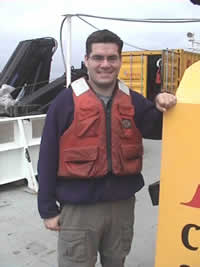|
Participant Perspective - July
26, 2001
 Interview
with Richard Leveille Interview
with Richard Leveille
Biogeochemist - University of Quebec at Montreal
Jeff
G: What is biogeochemistry?
Richard:
Biogeochemistry is the study of how biological organisms influence earth
processes. Their activity influences geochemical processes that we
previously thought were nonbiological. For instance, microorganisms are
known to influence the formation of minerals. They can also alter and
weather minerals through their various metabolic functions. The more we
study the Earth, the more we realize that bacteria are everywhere, at
the surface, in the deep-ocean, and deep within the crust. It's a really
broad field that's thriving.
Jeff:
What project are you working on at Axial Volcano?
Richard:
I'm looking at bacterial alteration of sulfide minerals at deep-sea hydrothermal
vents. Basically we're trying to get an idea of how fast sulfide deposits
(chimneys) at hydrothermal vents are altered and weathered. We know that
as they get older and die, they start to degrade and rust. Eventually
they crumble to bits and pieces. This process involves chemical reactions
and physical process that take place at the bottom of the ocean. We're
trying to see if bacteria also play a role in the weathering process of
the chimneys. On land, most of our major mines are from various metal
sulfides, much like those at the vents. When these deposits are exposed
to air and water they form acidic waste which we call acid mine drainage.
We know there's bacteria involved in this process that break down the
sulfides that eventually forms sulfuric acid. This acidic mine runoff
leads to all sorts of problems with leaks into rivers. There are bacteria
that are known to do similar kinds of things as these acidic bacteria
but they do it at a more neutral pH. So, we're trying to see if those
neutral types of bacteria are found at the vents and whether they're involved
in breaking down these sulfides. We're also doing lab experiments to simulate
the near-vent environment with and without naturally-occurring bacteria
to get a good qualitative estimate on the rates of alteration of the chimneys.
Jeff:
Is there a way to apply what you're finding out at the vents to solve
mine drainage problems on land?
Richard:
Yes. If we can find bacteria that break down sulfides at a neutral pH,
then perhaps we can use that knowledge, or the organisms themselves, to
bioleach mineral deposits on land. Bioleaching is a common biotechnological
application used now, but it usually involves acid-loving bacteria. If
we could bioleach at a more neutral pH and still get these metals out
of the sulfide minerals, we might not have this acid mine drainage problem.
|

